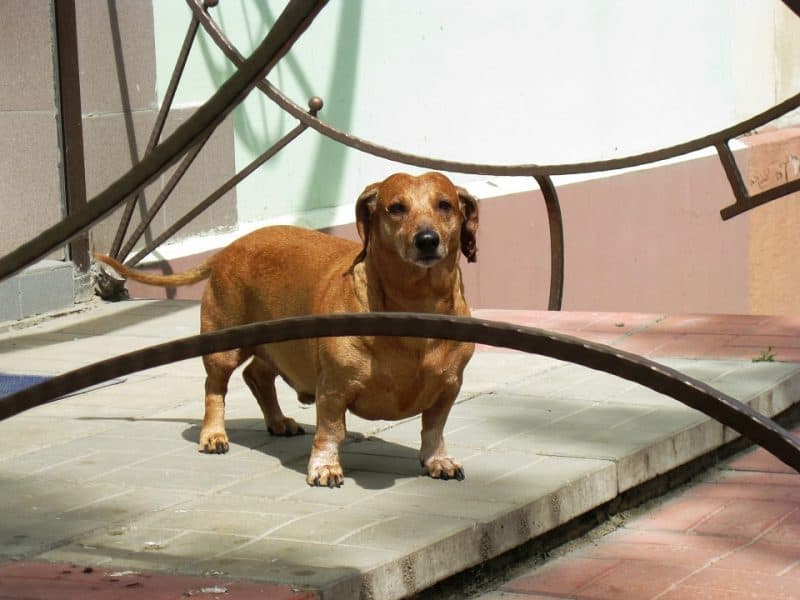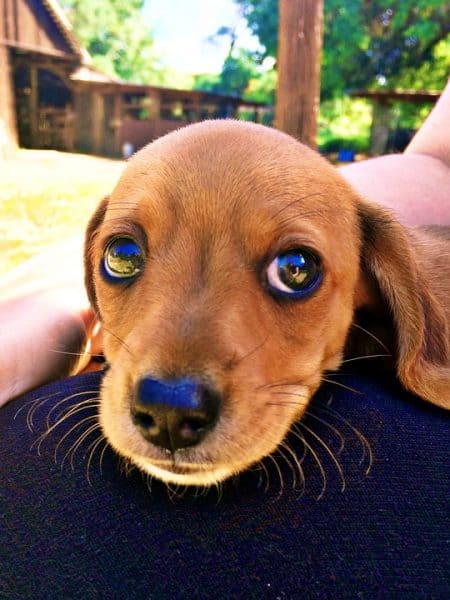- Dachshund Pregnancy and Whelping
- When can my Dachshund get pregnant?
- At what age can a dachshund get pregnant?
- How to know if my dog is pregnant?
- Stages of dachshund pregnancy
- Symptoms of a pregnant dog
- How to care for a whelping dachshund?
- The process of dachshund whelping
- Postnatal Care
- How to care for a newborn Dachshund puppy?
- Dealing with an accidental dog pregnancy
- Conclusion
Deciding to breed a dog is something that should not be taken lightly. Breeding a Dachshund requires a strong long-term commitment and dedication during the entire process. You will also be ready and willing to assume all the financial costs associated with the dachshund pregnancy, like medical bills. Finally, you will have to be responsible for future puppies. This means taking care of them as well as making the effort to find good homes for the puppies.

Dachshund Pregnancy and Whelping
If you want to breed your dachshund or have an unplanned dachshund pregnancy, this short guide will tell you everything you need to know.
Dachshund’s pregnancy is not particularly complicated. However, when breeding small dogs like Dachshunds there is the possibility of complications and in some cases, a C-section might be needed. In most cases though, pregnant doxies won’t experience complications. If you take special care of your pregnant Dachshund and follow the advice of your veterinarian, both the mother and her puppies will be healthy.
Perhaps the most important aspect of dachshund breeding is to make sure that both parents are healthy. Before mating, both the male and female should get a full medical examination by a veterinarian. It’s very important that both dachshunds have their vaccines up to date and that they are dewormed and free of parasites before mating. It’s also very important to feed your dog high-quality food at least a month before breeding. Your female dachshund will need excellent nutrition before and during the pregnancy, and while she is nursing the puppies.
When can my Dachshund get pregnant?
Understanding your dog’s reproductive cycle is very easy. Female dogs are fertile when they are in heat. This is a process called estrus, and it occurs twice a year every six months. This process lasts 21 days and consists of four stages.
- Proestrus: This is the initial stage of the heat cycle and lasts around 9 days. In this stage, your dachshund’s vulva will swell and emit a bloody discharge. At this stage, your female dachshund will start to attract males, but she will reject any advances.
- Estrus: This stage lasts from 3 to 11 days. At this stage, the female’s vulva will be enlarged and the discharge will decrease and lighten in color. This is when your female dachshund will be receptive to males and mating can occur.
- Diestrus: This is the final stage of the cycle, it occurs around day 14. In this stage, the vulva starts returning to its normal stage and the discharges begin to taper off. At this time the female will start rejecting males and won’t permit mating. This stage ends when the swelling in the vulva is gone.
- Anestrus: This is the time between reproductive cycles, and will last for the next six months until the heat starts again.
Related post: New Dachshund Puppy Checklist | Essential Supplies for your new puppy

At what age can a dachshund get pregnant?
Dachshunds can get pregnant in their first heat cycle, however, this is not advisable. Dogs should be bred when they achieve full maturity, which doesn’t happen until their second full heat cycle. This means that it is ok to breed a female dachshund from one year of age. It is also not recommended to breed a female dachshund after 12 years of age.
How to know if my dog is pregnant?
The best way to determine if your dachshund is pregnant is with a blood test performed at the veterinarian. around two to three weeks after mating your vet will be able to know for sure if your dachshund is pregnant or not, this is done through either a blood test or an ultrasound test. Some physical and behavioral signs will let you know your dog is pregnant (these signs only start to show around 3 weeks into the pregnancy):
- Enlarged nipples
- Lower Energy levels
- Morning Sickness (dogs can also get morning sickness as humans do
These are the type of tests that can be performed by your vet to diagnose and monitor a pregnancy:
- Hormone tests: This test detects a hormone called relaxin. this hormone is released by the placental tissue during pregnancy. However, this test is only accurate if your dachshund is at least 30 days into the pregnancy.
- Palpation: This is the most traditional and cheapest way to diagnose a pregnancy. In this test, the vet will feel the sacs formed around the fetuses. This test should be performed between 21 to 35 days into the gestation period.
- Ultrasound: This is the best method to diagnose a pregnancy. It should be done between 25 to 45 days of the gestation period. This test can diagnose the pregnancy as well as the health of the puppies by registering the heartbeats. It can also determine the exact gestational age of the puppies.
Stages of dachshund pregnancy
A typical dog pregnancy will last around 63 to 65 days. However, birthing can also occur as early as 53 days and as late as 71 days. However, if your dachshund shows no signs of labor after day 65, check with the vet to make sure there is no problem.
When a dachshund is pregnant, one of the first signs you will notice is that her nipples will get enlarged. On some occasions, pregnant dogs will also suffer from morning sickness. Another sign is weight gain, you will notice a slight increase in your dachshund’s body mass. Dachshund mommas will eat more during pregnancy, thus the weight gain during the first weeks of pregnancy. There is a condition that occurs after breeding, known as “false pregnancy” in which your doxie might exhibit the symptoms of pregnancy. That’s why is very important to take your dachshund to the vet to confirm the pregnancy.
How many puppies can a dachshund have in a litter?
The number of puppies in a litter will depend on the type of dog. Small breeds like Dachshunds can produce between 1 and 6 puppies in a litter. Most dachshunds give birth to 3 to 4 puppies per litter.

Symptoms of a pregnant dog
Around four weeks after mating, your dachshund’s abdomen will grow a little, it will be noticeable but not significant if your dog is carrying a large litter, and the growth will be more evident. At this stage, you will also notice that your dachshund will experience clear vaginal discharge. Keep in mind that your pregnant dachshund will not only need to eat more food (50% more than usual) than usual but will need high-protein foods, ask your vet which type of food is the best option for your dachshund.
As the dachshund pregnancy progresses, your doxie will gain more weight and her belly will be significantly swollen. In the late stages of pregnancy, your dog will be less active, and moving around may be difficult for her. It’s recommendable that your dachshund doesn’t go up and down stairs or try to jump up onto your bed or sofa, to avoid any possible damage to the puppies.
How to care for a whelping dachshund?
When the dachshund pregnancy reaches its end and whelping is about to start your doxie will go to a place where she feels comfortable and protected. Another sign is loss of appetite, around 24 hours before whelping your dachshund will lose interest in food.
You might notice that your dachshund will lick her vulva repeatedly and experience contractions a few hours before delivery. Once the whelping starts you will start to see a gray water sac coming out of your dog’s vulva, your dog will probably bite on the water sac to break it. After the water sac is broken, the puppies will start to come out, do not pull on the puppies!
The first puppy will be the hardest, moaning and signs of pain are to be expected. Each puppy will be born inside a placental membrane, your dachshund will probably break the membrane and eat it. If she doesn’t do that, you will have to remove the membrane. Your dachshund will also bite the umbilical cord. However, be prepared with sterilized scissors to cut the cord if necessary. cut it 1 or 2 inches from the puppy.

The process of dachshund whelping
The whelping process can take a few hours, most dachshunds can give birth at home and don’t need to go to the vet. You do need to call your vet and keep in touch during the process and give your vet a constant update until the whelping process is over. Your dachshund may want to drink water and eat some food during the process. Make sure she has her food and water bowls nearby during the labor so she doesn’t have to move.
If there are complications during the whelping process you will need to call your Vet for help and take her to the veterinary clinic. Keep an eye on these signs of trouble: Excessive bleeding, extreme pain, trembling, and bloody discharge before the first puppy is born. Keep track of the time, if more than two hours pass between the birth of each puppy or your dachshund experiences more than 45 minutes of contractions with no births, call your vet. These are also signs of possible problems, there is no need to panic if any of those things happen. Just call your vet and inform him of the symptoms. If there are any serious complications during the whelping your Vet might need to perform a c-section.
Postnatal Care
Postnatal care is vital for the health and well-being of both the mother and her puppies. Monitor the puppies closely and ensure they are nursing adequately. Schedule a postnatal check-up for your Dachshund to ensure she is recovering well from the pregnancy.
How to care for a newborn Dachshund puppy?
Newborn puppies have trouble controlling their body temperature. To keep the puppies warm, using a heat lamp or an electric heating pad is a good way to provide a warm environment. However, overheating can be dangerous to the puppies, so make sure that the puppies have a cool place where they can crawl to cool down. The adequate temperature for a newborn puppy is between 85 and 90 degrees.
Make sure that the puppies ingest their mother’s milk or colostrum as soon as they are born. If your dachshund is unable to nurse the puppies they must be hand-fed with puppy formula, cow milk is not a good substitute for dog milk.
Puppies grow fast. Weighing them every day is a good way to register and monitor their growth.
Around two to four weeks of age, it’s time to start the process of weaning puppies from their mother’s milk. Consult with your vet and set a feeding regimen for the puppies. Most breeders use puppy formula and pre-soaked puppy food in this process.
Check out this related post: How To Raise a Happy and Healthy Dachshund

Dealing with an accidental dog pregnancy
If the mating occurs accidentally, or you suspect that your female dachshund may have bred, take her to the vet as soon as possible. The best thing to do is to take a blood test the day or the day after the mating. This will determine if your female dachshund is fertile. If your dachshund was not ovulating at the time of the mating keep in mind that the pregnancy can still occur. Take your dachshund to the vet for a pregnancy test a week after the mating to be sure if she is pregnant or not.
If you want to find the best pet insurance for your dachshund, click here
Conclusion
Congratulations on taking the first step towards understanding Dachshund’s pregnancy. We hope this comprehensive guide has provided you with valuable insights and information to ensure a smooth and successful pregnancy for your beloved Dachshund. Remember to consult with a professional veterinarian for personalized advice and care during this special journey. By providing the best care possible, you’ll be well on your way to a healthy and happy litter of Dachshund puppies. Happy breeding!
Related post: Dachshund Care: A Complete Guide to Keep Your Dachshund Happy and Healthy




